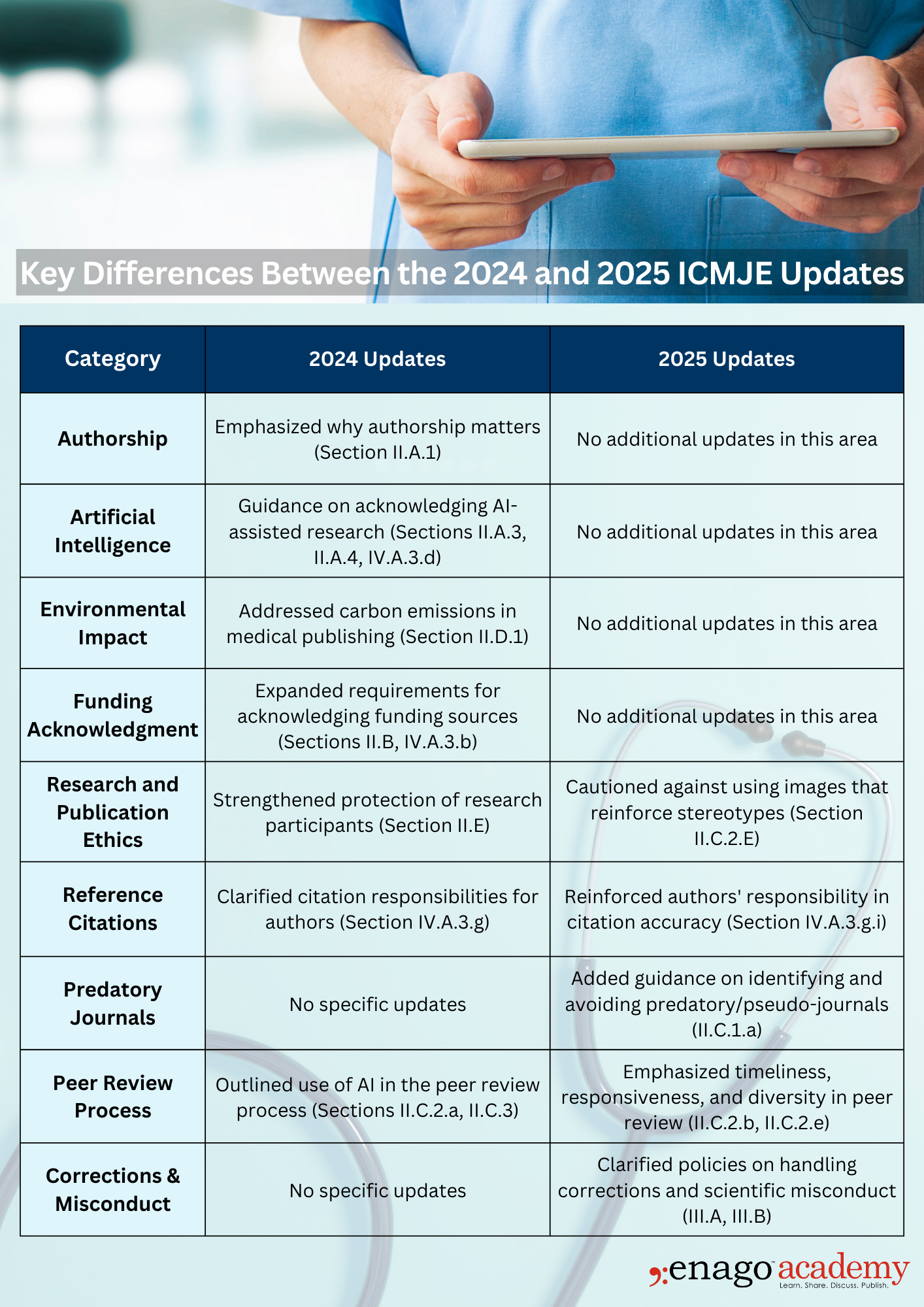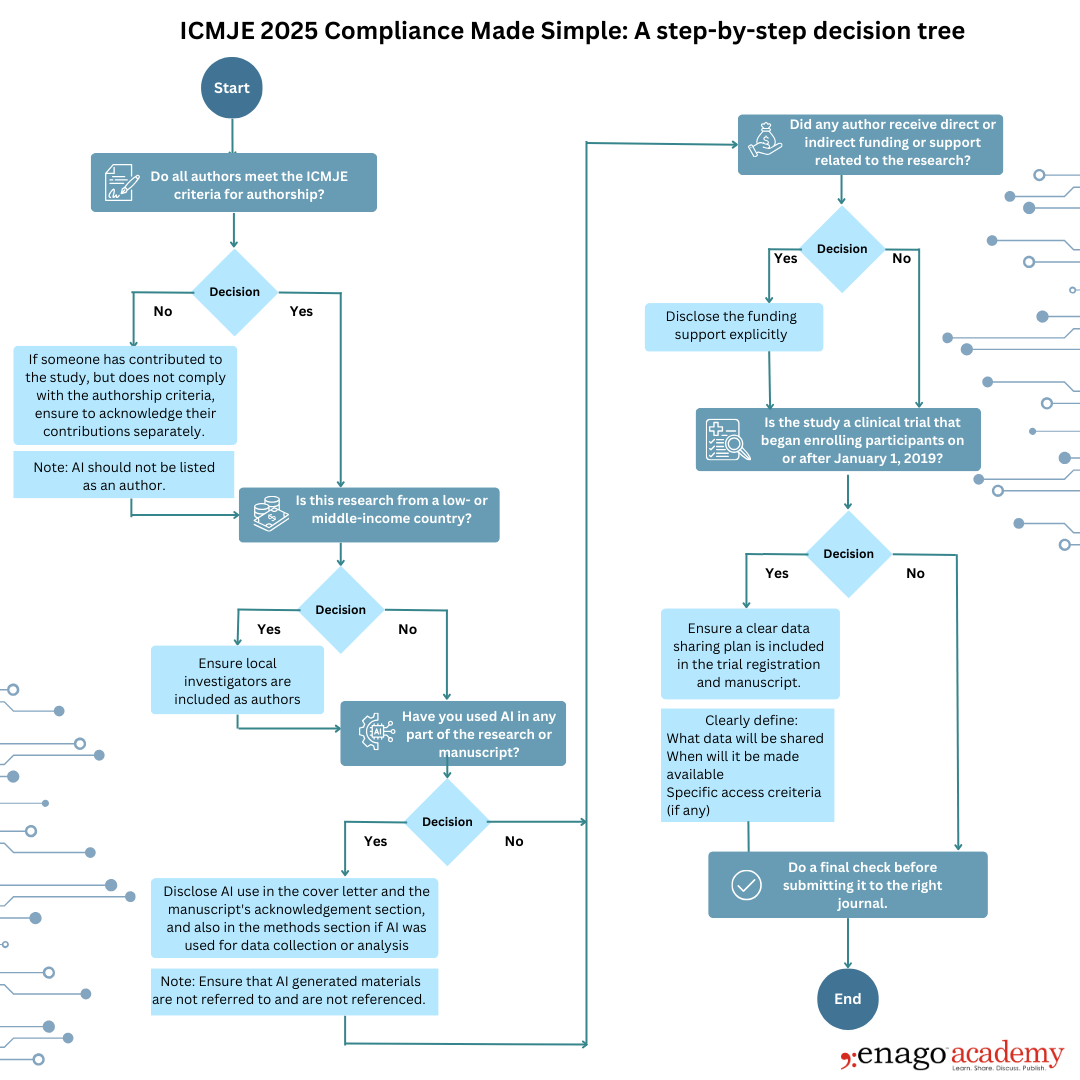ICMJE Updates 2025: A new era for ethical research publishing

The integrity of medical and scientific publications is crucial for ensuring the reliability of research findings. Historically known as the Uniform Requirements for Manuscripts, The International Committee of Medical Journal Editors (ICMJE) has been playing a critical role in this landscape since 1978. These recommendations address various ethical aspects of scholarly publishing, including authorship criteria, conflict of interest disclosures, and others.
The latest updates from the ICMJE, released in January 2025 is built upon previous recommendations with a continued focus on inclusivity, responsible use of Artificial Intelligence (AI) and transparency. As publishing practices evolve, it is crucial for researchers, reviewers, editors, publishers, journal owners, and institutions to stay updated on these guidelines to uphold credibility and adapt to the emerging ethical challenges.
Key Areas Addressed in the Latest ICMJE Updates
Strengthening Authors’ Responsibility for Accurate Referencing (Section IV.A.3.g.i)
The 2025 update holds authors as the sole stakeholders responsible to provide accurate references. They are also required to attest the appropriateness of the reference cited to support their claim wherever necessary. Referencing AI generated material continues to be prohibited.
Implication: Citing inaccurate sources spreads misinformation affecting the foundation of medicine and research. Holding authors accountable for reference accuracy, including prohibiting AI-generated citations, strengthens the credibility of their work.
Pitfalls to Avoid:
- Including incorrect or unverified references
Caution Against Publishing in Predatory or Pseudo-Journals (Section II.C.1.a)
The ICMJE has laid out extensive resources identifying predatory or pseudo-journals and has advised authors to be cautious while selecting journals for publications.
Implication: Greater awareness of predatory publishing practices will encourage researchers to carefully assess journal credibility before submission, protecting their work from being exploited and avoiding any damage to their reputation.
Pitfalls to Avoid:
- Submitting to journals with no transparent peer review or indexing
- Falling for misleading impact factor claims
- Publishing in journals that may not be recognized by institutions or funders
Promoting Corrections and Version Control (Section III.A) and Addressing Scientific Misconduct (Section III.B)
This year’s update clarified that debates and evolving concepts do not constitute as errors and these could be handled through letters, or as new publications, as per the situation. It also outlines procedures for addressing scientific misconduct, including issuing retractions when necessary.
Implication: This prevents unnecessary retractions and promotes dialogue among the stakeholders and offers collective responsibility.
Pitfalls to Avoid:
- Mislabelling academic debates as corrections or retractions
- Lack of clear policies on handling updates, leading to confusion for readers and authors
- Failure to transparently document changes, affecting trust in the publication process
Preserving Dignity and Equality of the Stakeholders and Upholding Publishing Ethics (Section II.C.2.e)
Journals are now advised to be cautious about publishing people’s images. It is advised that extra care be taken to avoid depicting any stereotypical ideas in the journals.
Implication: Depicting people responsibly respects their dignity and rights, particularly in sensitive fields like medical research where images may depict patients, participants, or marginalized communities. It prevents stereotypes, biases, and misrepresentations, fostering a more inclusive and respectful community.
Pitfalls to Avoid:
- Using images without considering their potential to perpetuate stereotypes
Encouraging Timeliness and Responsiveness in the Peer Review Process (Section II.C.2.b)
The 2025 update focusses on timeliness and responsiveness of journals and explicitly states that journals should respond to author queries on the status of the manuscript in a timely manner.
Implications: Delays and poor communication during peer review slow scientific progress and can ultimately impact timely patient care. This update pushes journals to provide timely updates, making the process more transparent and efficient.
Pitfalls to Avoid:
- Failing to communicate status updates to authors during the review process
- Failing to track or follow up on manuscript reviews on time, leading to delayed decisions
Key Differences Between the 2024 and 2025 ICMJE Updates
 These updates reflect the evolving landscape of research integrity and ethical publishing in scholarly communications. It is essential for the stakeholders to understand how these changes impact their roles and responsibilities to ensure smooth adoption of the guidelines.
These updates reflect the evolving landscape of research integrity and ethical publishing in scholarly communications. It is essential for the stakeholders to understand how these changes impact their roles and responsibilities to ensure smooth adoption of the guidelines.
Here’s a comprehensive decision tree guiding authors on adhering to the latest ICMJE updates. The decision tree helps authors determine whether their manuscript complies with key ICMJE guidelines on authorship, AI use, conflict of interest disclosures, and data sharing.
 Understanding and adhering to the ICMJE guidelines is the responsibility of all stakeholders. This, in turn, helps maintain research integrity and publishing ethics in medical and scientific publications. These guidelines are constantly updated to address the rising challenges posed by latest advancements in the publishing field. By embracing these guidelines, researchers and editors can contribute to a more transparent, reliable, and inclusive scientific literature.
Understanding and adhering to the ICMJE guidelines is the responsibility of all stakeholders. This, in turn, helps maintain research integrity and publishing ethics in medical and scientific publications. These guidelines are constantly updated to address the rising challenges posed by latest advancements in the publishing field. By embracing these guidelines, researchers and editors can contribute to a more transparent, reliable, and inclusive scientific literature.









